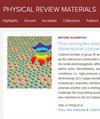Strong correlation between ionic bonding strength and superconductivity in compressed hydrides
IF 3.4
3区 材料科学
Q2 MATERIALS SCIENCE, MULTIDISCIPLINARY
引用次数: 0
Abstract
Understanding the superconductivity in relation to chemical bonding is essential for the development of superconductors. We propose that pressure-reduced ionic bonding strength is beneficial for improving superconductivity in hydrides (negative correlation between bonding strength and critical temperature). We model ionic hydrides using a prototypical ionic lattice (CsCl-type) with simple-valence metal Li/Rb and hydrogen and control the bonding strength via external pressure. First-principles calculations reveal that the ionic bonding strength in LiH increases with pressure while its critical temperature () simultaneously decreases. A higher at lower pressures is attributed to stronger electron-phonon coupling (EPC) induced by weaker ionic bonds and significant EPC contributions from mid-frequency phonons. RbH's pressure dependences of bonding strength and are the reverse of those of LiH, and the EPC primarily results from high-frequency phonons. The distinct interorbital electron transition mechanism and amounts of charge transfer are responsible for the opposite trend of changes in bonding strength and superconductivity in LiH and RbH. The proposed correlation is further validated by the other six ionic hydrides. Substantial change (e.g., 126.2 K at 100 GPa and 5.7 K at 300 GPa in LiH) in response to bonding strength variation reveals a key factor for designing new superconductors.

压缩氢化物中离子键强度与超导性之间的强相关性
了解超导性与化学键的关系对于开发超导体至关重要。我们提出,压力降低的离子键强度有利于提高氢化物的超导性(键强度与临界温度呈负相关)。我们使用带有单价金属 Li/Rb 和氢的原型离子晶格(CsCl 型)来模拟离子氢化物,并通过外部压力来控制键合强度。第一性原理计算显示,LiH 中的离子键强度随压力的增加而增加,而其临界温度(Tc)却同时降低。较低压力下较高的临界温度(Tc)归因于较弱的离子键引起的较强的电子-声子耦合(EPC)以及中频声子的显著 EPC 贡献。RbH 的键合强度和 Tc 的压力依赖性与 LiH 相反,EPC 主要来自高频声子。不同的轨道间电子转变机制和电荷转移量是导致 LiH 和 RbH 的成键强度和超导性出现相反变化趋势的原因。其他六种离子氢化物进一步验证了所提出的相关性。键合强度变化引起的 Tc 的显著变化(如 LiH 在 100 GPa 时为 126.2 K,300 GPa 时为 5.7 K)揭示了设计新型超导体的一个关键因素。
本文章由计算机程序翻译,如有差异,请以英文原文为准。
求助全文
约1分钟内获得全文
求助全文
来源期刊

Physical Review Materials
Physics and Astronomy-Physics and Astronomy (miscellaneous)
CiteScore
5.80
自引率
5.90%
发文量
611
期刊介绍:
Physical Review Materials is a new broad-scope international journal for the multidisciplinary community engaged in research on materials. It is intended to fill a gap in the family of existing Physical Review journals that publish materials research. This field has grown rapidly in recent years and is increasingly being carried out in a way that transcends conventional subject boundaries. The journal was created to provide a common publication and reference source to the expanding community of physicists, materials scientists, chemists, engineers, and researchers in related disciplines that carry out high-quality original research in materials. It will share the same commitment to the high quality expected of all APS publications.
 求助内容:
求助内容: 应助结果提醒方式:
应助结果提醒方式:


